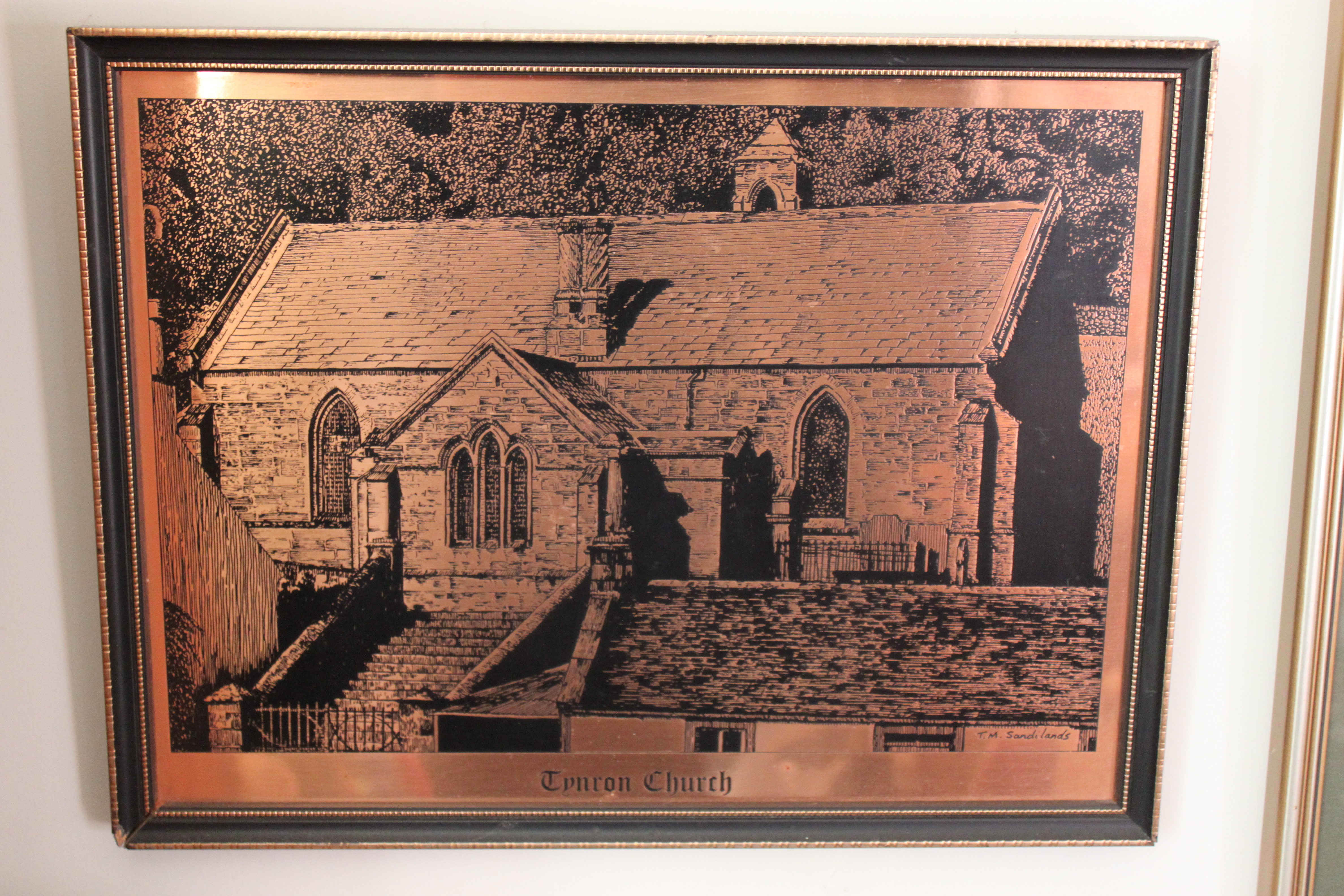
Tynron Kirk by TM Sandilands
The kirk is sited on a prominent knoll on top of the remains of many previous kirks. Tynron village has gathered round the kirk at a river crossing and a minor road junction.
Ministers
Names and details of the ministers since 1540 can be found in Fasti Ecclesiae Scoticanae, available in the Ewart, but here is an abbreviated list:
Sir Robert Welsh - 1540-1568 was probably a monk from Holywood.
William Taylor - 1568-1604? was previously in Penpont and Glencairn. He renounced the Papish religion.
Richard Brown - 1604-1645
John Lidderdale - 1644-1662 was deprived of this charge on the establishment of Episcopacy.
Robert Ramsay - 1664-1677 was presented by Charles II and thus conformed to Episcopacy.
David Laing - 1677-1689 deserted his charge at the Restoration.
John Murray - 1691-1700 first minister after the Restoration of 1689.
Simon Riddell - 1701-1743 in 1715 marched to Stirling against the Jacobites with several parishioners.
Thomas Wilson - 1743-1780 was the first minister presented by the Duke of Queensberry. He was a Wilson of Croglin.
James Wilson - 1780-1827 nephew of above. Had 6 daughters and 2 sons.
Robert Wilson - 1828-1870 was related to the above. He was the first minister known to have been born in Tynron, at Auchengibbert. He had eight daughters before he had his only son.
David Couper - 1871-1906 was seen as a squire as well as a minister. He had two daughters, three maids, a laundry woman, a coachman and a gardener-cum-odd-job-man.
Samuel Gilfillan Carmichael - 1906-1938.
There is a story worth repeating about the Rev Carmichael. Next to the manse was a piece of land where tinkers used to stay and one day when they moved on they left a dead donkey. The minister asked the council when they were going to remove the corpse. The man from the council replied that he thought the minister was responsible for dealing with the dead of the parish. Carmichael, who was much of a character, then stated that he was just informing next of kin!
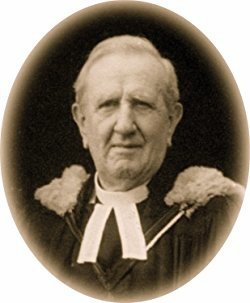
Rev John McWilliam
The last minister was quite a famous character, John Morell McWilliam from 1938-65. He was a well-known birdwatcher, the first Honorary President of the Scottish Ornithologists’ Club no less. He is said to have spent all his time on birds and writing bird books, while his wife did the parish work. He was Irish and was often so moved by his own preaching that he had tears in his eyes. Scotland’s Minister for Ornithology was his nickname.
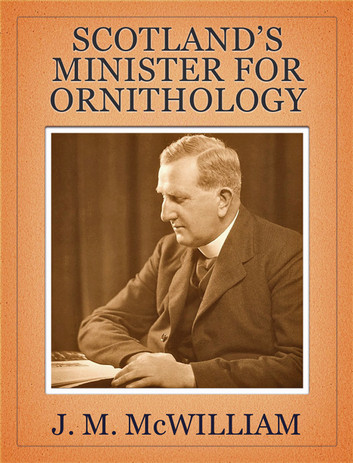
When McWilliam died the manse was quickly sold, renamed The Garth and Tynron sadly ceased to be a separate parish, when it was linked with Glencairn and Moniaive on 27 November 1966. Rev John Richard from Glencairn manse then served Tynron until his retirement in 1976. Then there was another change when Tynron was linked with Penpont and Keir. Rev James Wilkie was in charge until 1994, when Robert Gehrke took over at Penpont. McWilliam pointed out that no Tynron minister had ever left to take on another charge! Make what you will of that!
Along with every other small kirk the threat of closure has hung heavily over Tynron church. It has not survived and another facet of old village life is gone. The church is for sale. What will become of it?
Tynron Chrurch
The first substantial church was built just after 1700, but there was a succession of older buildings before that going back to the twelfth century and there is a long association with St Cuthbert. Cuthbert was an Anglo-Saxon, a monk and later bishop of Lindisfarne. Cuthbert may not have visited this area, but his remains were transported round the country after Lindisfarne fell to the Danes in 875.
The communion cups date back to 1610. Half the roof of the church of 1700 fell down in 1750, but unfortunately freestone from Tynron Doon was used to rebuild it. There were further major repairs in 1787 which made the church comfortable except when snow penetrated the crevices in the roof!
Tynron Kirk was again in a ruinous state in 1834 and the present building was built in 1837 for £975 by John Dalyell of Minnyhive. The architect was William Burn of George Street, Edinburgh. His plans are in the RCAHMS in Edinburgh and it seems that he initially envisaged a simple rectangular building. Burn was a famous architect with hundreds of commissions, including many churches, eg Keir, Morton and Langholm and lots of country houses including a number for Buccleuch and also the Crichton in Dumfries. He designed buildings all over Scotland and England.
The church was rebuilt in 1889 when there was a fashionable wedding to reopen it, Marion Brown, daughter of Adam Brown at Bennan. There were huge crowds and schoolchildren were given a bag of edibles and a sixpence.
The heritors were liable for the upkeep of the kirk. Even in 1912 Mr MacRae was being asked for a levy of two pence in the pound rental to meet the cost of new windows. MacRae duly paid his share, £2.7s. MacRae also had to pay £23.9.2 towards the minister’s stipend.
Until fairly recently pew rents were paid by the heritors, whereby pews would be reserved for the family and servants. In 1908 Mr MacRae from Stenhouse enquired as to how much pew space the MacRaes were entitled to. The total pew length was duly measured, the Duke of Buccleuch consulted, and MacRaes were allotted two seats and a bit. (The majority of the pews were allocated to Buccleuch). This was even though the MacRaes themselves attended the Free Church in Dunreggan.
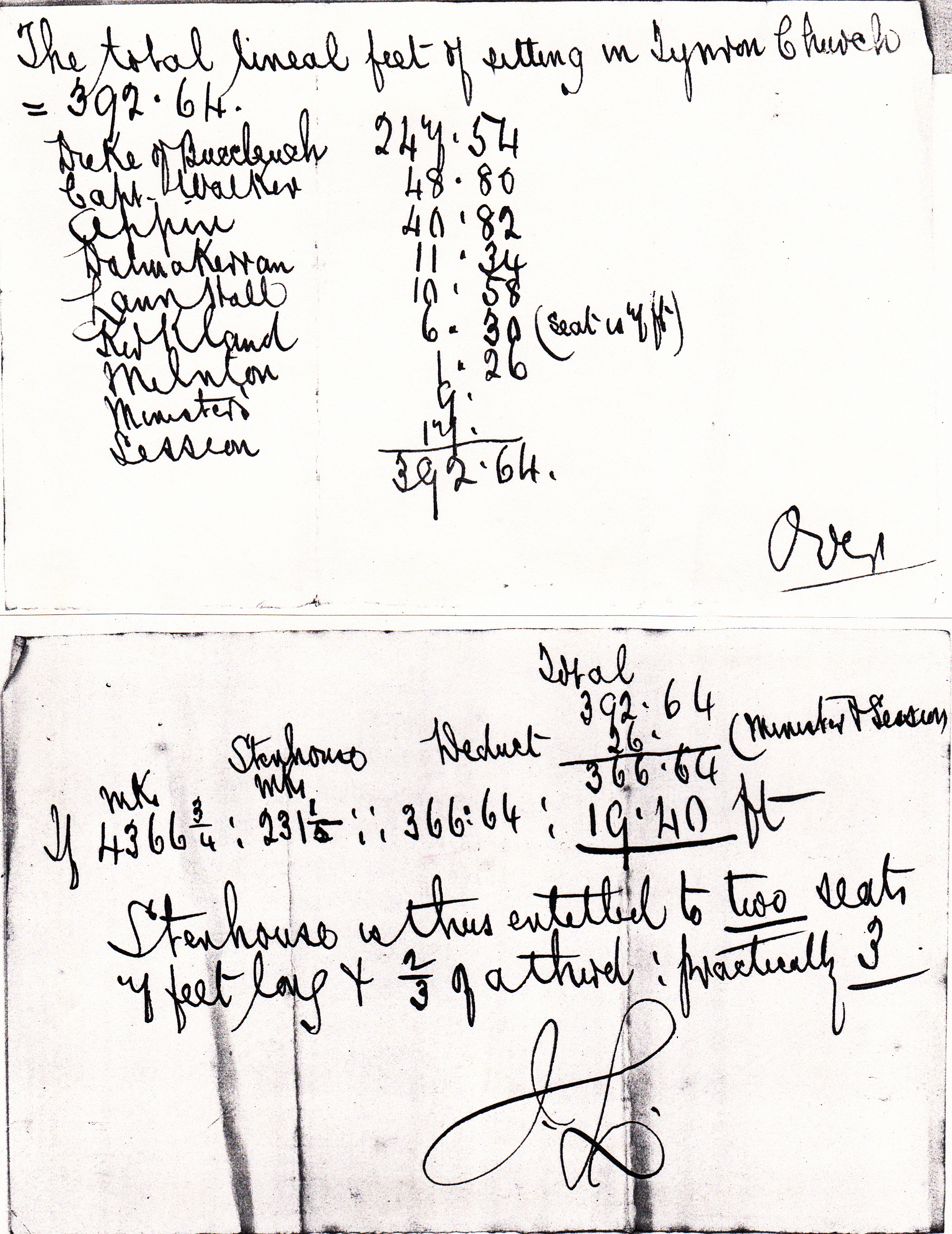
In 1834 The General Assembly of the Church of Scotland removed the absolute right of landowners to appoint the minister. Male communicants who were heads of families could veto the appointment of any new minister.
Some Tynronians, like MacRae, had left the Church of Scotland with the formation of the evangelical Free Church in 1843 and had to make the long walk over the hill to the new kirk at the end of Dunreggan, now in ruins. Some preferred the Cameronians at Scaur church in Penpont.
James Shaw gave this account of births, marriages and deaths 1865-95:
On Sundays waggon loads of children, carefully packed in straw, presided over by the maternal or paternal owner, or both, would pass my home on the road to the church. Wives and maidens, who could not command such a conveyance, walked past, their shoes and stockings in a napkin, ready to be put on at the rivulet’s side nearest the church. At that time the greater part of the families in my district were Cameronian or Reformed Presbyterian. At the present time the Parish Church has the greater number of adherents, and it being a much nearer place of worship, these modes of travelling are wearing out.
Ever since I came to Tynron, the child enters the Christian Church on a secular day. Neighbours are invited and the table groans with every kind of food. Butter (salt, fresh or powdered), bacon and eggs, sweet milk and skimmed milk cheese, potato scones, soda scones, drop scones, treacle scones, tea and a dram are part of the fare. The shepherds have a very restricted number of baptismal names. At one time the fourth of my schoolboys were “William”.
Weddings are celebrated in the same hospitable and jovial style. I have sat in a barn or cheese-room, the walls of which were lined with sheeting to protect our clothes, the floor sawdusted for dancing. The built-in boiler was transposed into a platform for the fiddlers. The tea was taken in relays. The minister, schoolmaster and small gentry occupied seats at the first table, which, along with forms for sitting on, was improvised from slabs for the occasion.
The commoner folk and young herds were next regaled at a second spread, while the elders smoked tobacco outside. The dances did not consist of walking, simpering and circling round each other with planetary regularity, but were like those that took place in Alloway church, as far as noise, life and motion were concerned. Towards morning came that awful ordeal, the pillow dance, or “Bob at the bolster”, an ingenious method of picking out the bonny and weel-liked and placing the less distinguished at the bottom of the class. The best man having picked out the bride, it next became her turn to throw the handkerchief to whomsoever she chose. The happy swain knelt as she stooped. The fiddlers shrieked a minuendo and the last kiss that ever alien lips should secure was wrested from the bride.
Funerals were well attended and the custom of having a service prevailed and only began to thin out after I entered the parish. I was told by a well-wisher to get acquainted with the people and to attend all the sheep shearings and funerals to which I was invited. The attendance at funerals is diminishing and generally a few gigs now pick up all the mourners. The exodus of young men and daughters into the large towns reacts on provincial simplicity. I witnessed wreaths of flowers heaped on the coffin of an old Cameronian, whose opinion, I am certain, had never been taken on the matter. The humblest family must have a memorial stone.
In the 1950s, 25 or 30 attended weekly services, but recently services have been restricted to just one a month at Tynron, run from Penpont, as part of the Penpont, Keir and Tynron Parish. Nevertheless the church and churchyard are kept in good condition by the council and a Covenanters Trail signpost has been erected. The kirk is surprisingly big inside and will hold some 314 people. The only time it does, though, is at the occasional wedding or funeral.
The oldest tombstone is of 1683, John Douglas of Stenhouse. From the opposite side of the religious spectrum is the stone of William Smith the Covenanter, but this stone dated 1685 is much later than the event. There is a 1692 stone of the Wilson family of Croglin and early 1700s stones of Glencorse and Brownrigg, old Tynron Families. Older graves are there but they have no stones. Most gravestones were made from Gatelawbridge sandstone, which has lasted fairly well. For a complete list of gravestones see Rev McWilliam’s exhaustive survey in TDGNHAS.
Village Hall
The Tynron Parish Hall was created about 1927-8. It was formed from a joiner’s workshop and stable, which properties were gifted by Misses MacRae. One of the original aims was to house the village library. It was also stipulated by the MacRaes in the agreement that no intoxicating liquor was to be sold on the premises. So what happens at dances now is a continual disappearance of the participants to their cars for a medicinal tot! Needless really, as there was also a stipulation that alcohol could be consumed in the hall on special occasions
Tynron Women’s Rural Institute
There had been great pressure for the building of a new hall in the twenties from the newly formed Tynron WRI, who had nowhere to meet, with the school hall not always being available. Tynron WRI has been going strong ever since. Competitions held have included:
- cardboard box covered in wallpaper
- potato peeling
- hopping
- bowl from a gramophone record
- whistling
- footstool made from syrup tins
- neatest ankles
- apron made out of a flour bag
- best sixpenny supper for one person
- peeling potato blindfolded.
- neatest parcel of a pair of shoes
Lots of Tynron WRI cards as early as 1924 are in the MacRae collection in the Ewart Library. At that time the women would walk down the glen in the dark evenings, carrying their lights. As each lady saw the lights coming, she would know it was time to leave the house and join the merry party walking down the glen road.

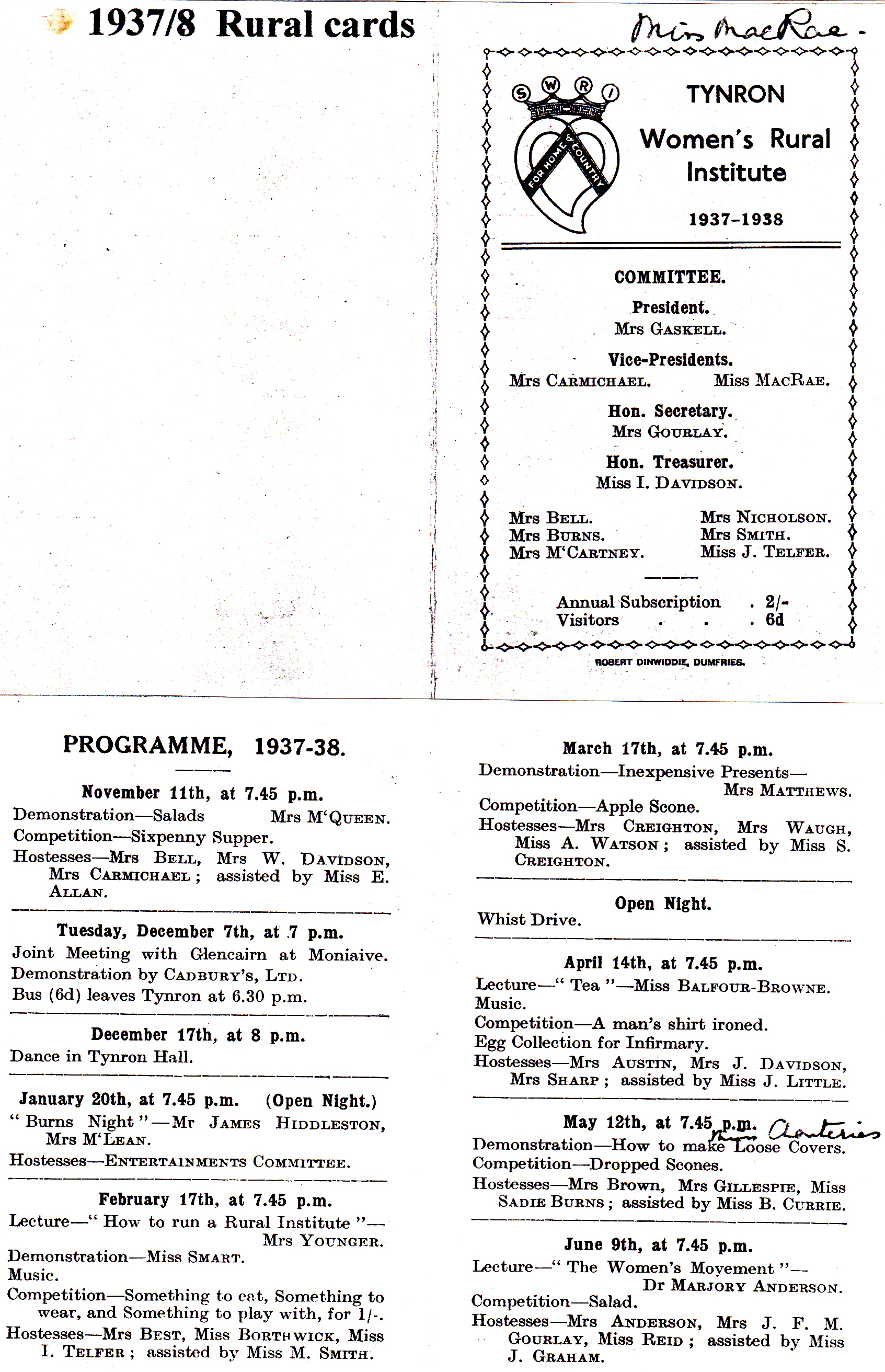
The village hall got a new car park in 1993 to go with the alterations which have put in Velux windows in the roof and repaired the flat roof. A grant has been obtained for this work, but materials and help have also been freely given by the folk of Tynron. The newly renovated and freshly painted hall is still used for Tynron Rural, carpet bowling, Halloween parties, dances, meetings and as a polling station.
Gas
A gasometer was marked on the 1856 and 1900 OS maps. It was sited by Lann Hall farmhouse and, as far as I can tell, must have supplied the village, as happened in Moniaive.
Electricity
Electricity came through the village in 1931-3. It was supplied by Dumfriesshire County Council from the Penpont-Moniaive line, though I am not sure how many houses in the village were connected, if any! The lines were low voltage and could only supply lighting, which cost £1 per room per annum. Stenhouse, of course, had been generating their own electricity from a water-wheel since 1907.
It was not until 1954 that the South-West Scotland Electricity Board put up an 11 kilovolt line and supplied Tynron’s outlying farms and cottages with enough to power all the latest gadgets available.
In 1991 new street lights were put up. One resident remarked that they no longer need to go to Blackpool for the illuminations! Nowadays unlimited power is available to every house and is taken for granted. How people complain nowadays if the power goes off for an hour or two!
Water Supply
Until 1924 the church, school and village were supplied from a tank situated above the church. The new village hall would have needed more water and there was already scarcely enough for the rest, so a new supply was laid on from Auchengibbert Linn above Kirkland.
The 1950s brought mains water. Nowadays water comes from Kettleton Reservoir, constructed in 1938, but this only goes up the glen to the two bridges. Water from Kettleton is gravity-fed into a tank at Auchengibbert, refurbished in 1991, from where it is piped down to the village.
Farms like Auchenbrack still have their own source from the hillside. Auchenbrack’s water kept flowing even in the tremendous drought of summer 1984, but barely.
Penpont’s water supply used to come from the spring across the road from Clonrae.
Public Services
The nearest police station is at Thornhill, but it is not manned all the time. A police car is almost a rarity in Tynron and sets all the tongues wagging. The fire engine has to come from Thornhill. Doctors from Moniaive and Thornhill and the district nurse provide an excellent service. Dumfries Infirmary deals with most of the hospital cases. The yellow library van travels up to Glenburn regularly. The mobile shop has stopped visiting recently, but there is still the fish van.
Buses
The motor car has all but killed off the bus services, but even in 1996 two buses and a daily postbus call in the village, connecting the glen with Thornhill, Moniaive and Dumfries. More regular buses run along the Clone road and do not call in at Tynron village, but they too are little used, as almost everyone uses a car.
Trains
Thornhill railway station opened in 1850. Now trains can be caught at Dumfries, Sanquhar (reopened 1994) or Kirkconnel, though the line is under threat and services reduced. The Cairn Valley Light Railway ran from Dumfries to Moniaive from 1905, but it was never very well used and was closed in 1943. Plans were drawn up at the turn of the century for a railway line from Thornhill to Moniaive, which would have passed over the Clone. It never came to fruition, so Tynron missed having its own station.
Life in Tynron?
There is still some life in Tynron, but no longer is agriculture the only raison d’être. The kirk cottages have been bought by the National Trust for Scotland, beautifully refurbished and sold on to suitable buyers. They have improved the appearance of the village and a good thing too, as one visitor was moved to write to the Standard about the appalling state of Tynron. Unfortunately, this letter was written while the post office was being done up and before Rose Cottage and the kirk cottages were improved. Tynron Kirk is now tidy, almost twee. Now planning permission has been gained, despite opposition, for a new house by the kirk cottages, now being built in 1996. No new house has been built in the glen since the fifties. It is extremely surprising that anyone is allowed to put up a new building in Tynron and now land has been cleared for a small new settlement at Lann Hall by the lodge.
Tynron village was made a conservation area in 1989 by Nithsdale District Council to stop the village being spoiled. This allows for the planned bungalow on the Island field. It is an eye-opener to see this 1.9 acre site valued at £32,000.
New residents are likely to be outsiders, some escaping from Scotland’s cities, some from overcrowded and overpriced England and either retired or working in Dumfries. By and large the “holiday home” crisis has not yet hit Tynron, though, as elsewhere, properties are out of reach of first-time buyers. Lann Hall and Kirkland are holiday homes at present and it seems outrageous that the National Trust for Scotland has made the newly-renovated corner cottage a holiday home. The community has protested that this is something the NTS should not be encouraging.
Tynron has the same problem as every other small community. Its sons and daughters leave as soon as they can, as there are no jobs and no houses available. Are these children of Tynron ever likely to return to stay?
The blessing or curse of tourism has not really hit Tynron. Not a holiday caravan nor a bed and breakfast. Not yet. The sight of a caravanette driving up the glen is still a novelty. Perhaps it is fortunate that the glen road is no-through-road and the steep hill to Moniaive protects Tynron from tourists. And yet Tynron Glen is as attractive as any in Scotland. Some would say that it is a good thing to be hidden away in the top left-hand corner of Dumfriesshire.
Tynron Community Council formed in 1991 meets regularly to discuss all the local issues.
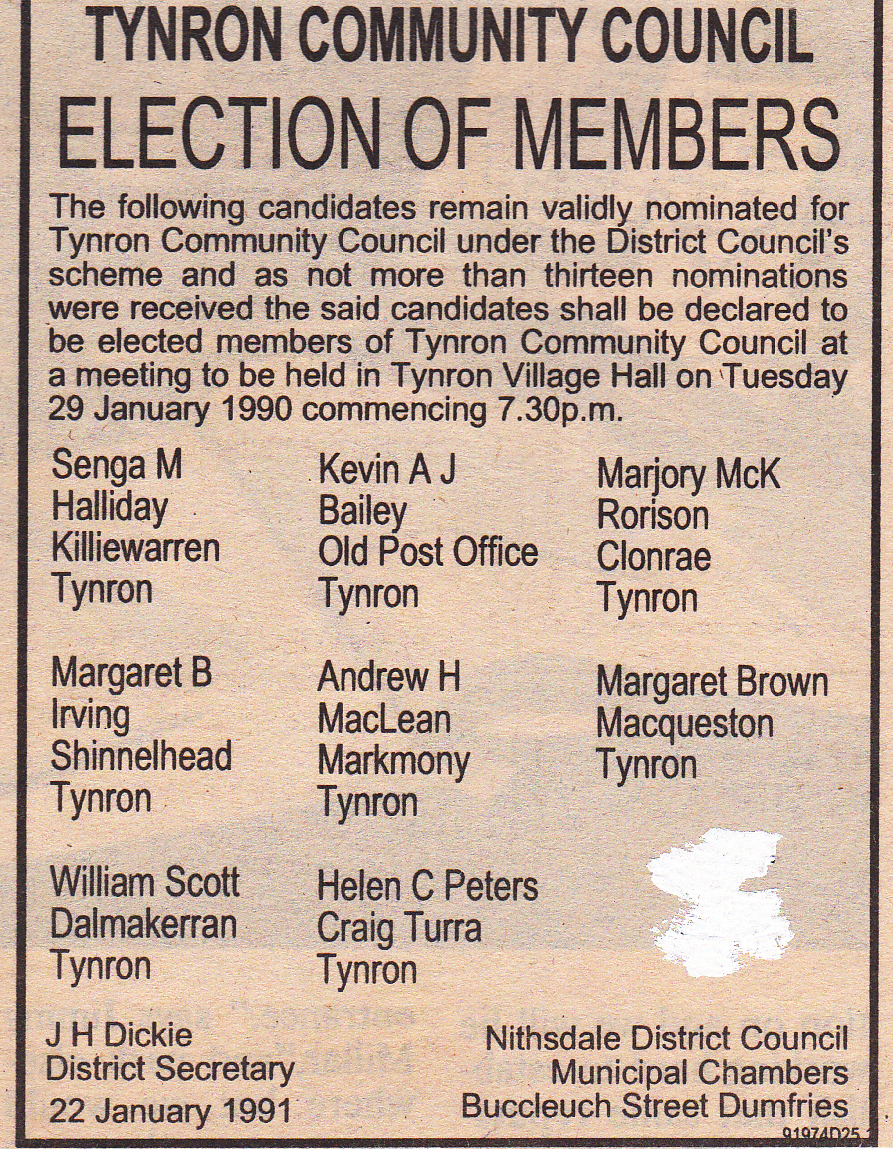
Twinning
The Auld Alliance Twinning Association of Keir, Tynron, Penpont and Dunscore has been very active. Tynronians have visited villages in L’Oise Department in France and the reciprocal visit of the French picked out the one wet day of June 1995.
The Hen Hoose
The Hen Hoose took over the buildings formerly used by the battery farm at Lann Hall in 1993. What an unlikely setting for an ambitious venture, restoring furniture and providing a centre for arts and crafts mainly for women. The bric-à-brac and the tearoom are certainly aimed at the tourist market and are attracting visitors into Tynron.
At least Tynron has enjoyed something it has not often done before – 50 years of peace. History shows that this will not last for long, but let us enjoy it while it lasts. The next war might be the last…
Football, Cricket and Sports
A late football result:
1896 Tynron 1 Moniaive 0, played on Tynron ground, the glebe.
Whatever happened to that fixture?
Cricket used to be played too at Stenhouse, even before the First World War. There is a photo of a team from 1922 in the Ewart, when they played on the field over the road from the village houses.
Sports were held too in the field by the village or on Dalmakerran Holm, especially on jubilees and other royal events.
Carpet Bowling
Carpet bowling is the big sport still played in Tynron. As late as 1958 it was still played in the old village hall 3 kilometres up the glen at Clodderoch, (pronounced Clodrie), now less than a ruin. Tynron Bowling Club were the tenants of Clodderoch in the 1930s. Looking at the ruins of Clodderoch in the 1990s it is difficult to imagine it being big enough for bowling and the village dances. But it was! The 1851 census showed six McCaws living there. In 1881 there were seven MacDuffs in Clodderoch.
Curling
Tynron’s great traditional sport has been curling. John Laurie’s pamphlet “Curling Songs of Tynron” 1870-6 has this wee poem:
Oor bonnie loch, the news is brocht
Wi’ twa-inch haup is cled
A braver sheet, mair true an’ sweet
King Johnny never spread.
In 1861 Tynron Curling Society was formed. There were games long before this, but nothing organised. In 1865 Tynron Core had a rink in fine condition.
There are many references in the newspapers to AGMs and matches in the nineteenth century. The curling loch was Aird Loch, which was somewhat smaller than at present, and Tynron’s successful years were the 1860s and 1870s. Back in 1863 they had used a sheet of ice in a neighbouring parish. The new loch at Craigturra was in use by 1886 (as seen below on the 1898 OS map), when Aird Loch was “open and exposed”. There were still three rinks in 1910 and curling was brilliant in the 1930s, when there was lots of ice. Tynron Curling Club was still renting the pond from Buccleuch in 1939 for one shilling per annum, and I imagine curling would have stopped during the war or just after.

In 1996 Craigturra Loch is overgrown with willows and totally unusable. Aird Loch could still be used, but it is difficult to imagine more than a very few days in the 1980s or 1990s when a suitable thickness of ice would have been formed. Perhaps a long term climatic change helped to put an end to curling.
Gardens and Crafts
The Glencairn and Tynron Amateurs’, Cottagers’ and Gardeners’ Horticultural Society is in its 117th year in 1996. In Moniaive in August all sorts of garden and industrial produce is exhibited and Tynron is quite well represented.